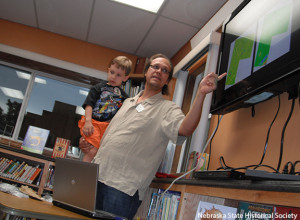We’re introducing a new feature of our blog called “Employee Spotlight.” Four times a year, we’ll interview a NSHS employee and showcase their projects and explain the work they’re doing to collect, preserve, and share Nebraska’s history. Nolan Johnson is one of several highway archeologists for the Historical Society. Since 2012, Johnson has worked to discover, document, and attempt to protect archeological sites and historic structures in the path of state and federal road projects in Nebraska. Johnson surveys, digs, and writes reports as part of his job, and his responsibilities vary by the season.
 Johnson pushes a “mag cart,” which is a series of magnetometers mounted on a plastic cart. Archeologists use these to look for areas where the magnetic field in the ground are different from the normal background fields of the earth, usually caused by burning, metal objects, or changes in the soil. This photo is from training Johnson attended in Kansas.
Johnson pushes a “mag cart,” which is a series of magnetometers mounted on a plastic cart. Archeologists use these to look for areas where the magnetic field in the ground are different from the normal background fields of the earth, usually caused by burning, metal objects, or changes in the soil. This photo is from training Johnson attended in Kansas.
Hollywood has portrayed archeology as a field with exotic locales and lucrative artifact findings, but the weather influences Johnson’s work more than ruthless competitors or Temples of Doom. “It’s not as glamorous as it sounds,” Johnson said. “A lot of days are spent digging empty holes or wandering around and not finding anything.” Johnson is currently writing reports and preparing for field work when the weather warms up more, but he has surveyed sites in ten degrees in January, sixty-five degrees in February, and one-hundred degrees in July. “A lot of our job is walking and looking at the ground, which is hard when it’s cold,” Johnson said. “If the ground’s frozen, you can’t dig. We also use a quarter inch mesh to screen dirt when we dig it up, and you can’t do that if the dirt is frozen. So you can’t really do the field science part in winter.” However, state highway archeologists also have to take advantage of the lack of vegetation during late winter and early spring. “Being such an ag state, when the crops get tall enough, you can’t really see the ground,” Johnson said. One such project is a historic flour mill made from rough-dressed limestone near Nebraska City. The archeologists are using an electronic distance machine to map the site, and they have to finish before the trees leaf out. “It uses lasers, so if the trees are full of leaves, you have no sight lines,” Johnson said. Another site is along Highway 12 near Ponca, which was discovered in 1940 before Highway 12 was built. Archeologists found three earth lodges under an abandoned railroad grade. The Nebraska Department of Roads then built the road at a later date. “We found coal, burned sandstone, pieces of plates and bottles, and nails from around 1900,” Johnson said. “We also found Native American ceramics over 4 feet below the right-of-way, but the road crews will not dig deep enough or far enough from the existing right away to affect them.” The archeologists also assist if roads projects uncover human remains. After local authorities have determined that the remains are not connected with any kind of homicide, archeologists provide forensic experience and work with families and tribal descendents, if possible, to ensure remains are properly repatriated. The archeology team works on these sites in a variety of ways. After initial surveying, they sometimes work with a geomorphologist to scan for materials below the surface. “We do shovel tests, which are up to 1.5 feet deep, and then sometimes we do deep testing, which is at 15 feet,” Johnson said. Everything that is found is carefully documented and added to Nebraska’s archeological database, which currently has about 11,000 sites.
 Johnson and his son Heywood give a presentation for Celebrate Nebraska Archaeology Month in September 2015.
Johnson and his son Heywood give a presentation for Celebrate Nebraska Archaeology Month in September 2015.
The Archeology Division of the NSHS has divided up Nebraska into six different districts, and each member of their team is in charge of a certain district while simultaneously assisting their colleagues with projects in other districts. Johnson’s district is northeast Nebraska. One of Johnson’s biggest projects is working with the proposed Highway 275 Expressway project. The highway, which runs from Omaha to Norfolk, is currently four lanes to Scribner, and road crews are building 40 miles of new four-lane from Scribner to Norfolk. “With 40 miles of new road, the odds of finding archeological remains are very high,” Johnson said. But new roads are not the only sites Johnson investigates. “When they’re bringing existing highways up to current safety standards – improving bridges, adding culverts, widening shoulders, straightening curves – we go out,” Johnson said. “When we go out and look at these projects, the roads crew doesn’t know all the details, so we check a wider area than what they plan to impact , so in ten years from now if they decide to expand the road, we won’t need to do it again.” NSHS archeologists also work on private land when research money is available or if burials are discovered, but otherwise they do not get involved with sites on private property. Unless human remains are involved, sites on private land or construction that isn’t government-sponsored are not protected by any law. “The NSHS’s role is to record and preserve,” Johnson said. “It’s not our job to stop road projects, but make sure cultural resources are taken care of in a timely and efficient manner.”



